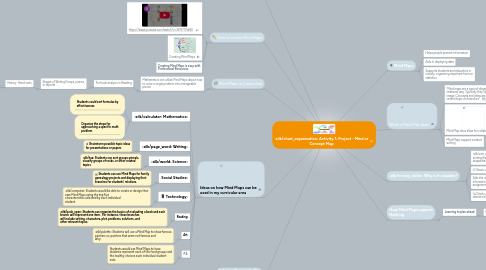
1. https://bubbl.us/
1.1. http://www.inspiration.com/visual-learning/mind-mapping
1.1.1. http://www.mindmeister.com/
2. Mind Maps
2.1. Helps people present information
2.2. Aids in displaying data
2.3. Supports students and educators in visually organizing important facts or statistics
3. What a Mind Map does
3.1. "Mind maps are a type of diagram used to visually display information in a relational way. Typically they start with a central idea, denoted by a word and/or image. Concepts and ideas associated with the central topic radiate out from the central topic on branches". http://oregonstate.edu/tac/how-to-use/mind-mapping
3.2. Mind Map does allow for collaboration:
3.3. Mind Maps support creative writing
4. Why is it valuable?
4.1. Younger students often have difficulty with sorting their thoughts into sentences or sequential order
4.2. Saves valuable time in repeated rough drafts
4.3. Aids the user in not missing vital information or figures in their projects or assignments
4.4. Clarity of the Mind Maps appeals to visual learners and provides a framework for success
5. How to create Mind Maps
5.1. https://www.youtube.com/watch?v=3iFH717xb90
5.2. Creating Mind Maps
5.3. Creating Mind Maps is easy with Professional Resources
6. Mind Maps in Curriculum
6.1. Mathematics can utilize Mind Maps depict how to solve a single problem into manageable pieces
6.1.1. For book analysis in Reading
6.1.1.1. Stages of Writing Essays, poems, or reports
6.1.1.1.1. History Hand-outs
7. How Mind Maps support thinking
7.1. Learning to plan ahead
7.1.1. Creativity in organizing information
7.1.1.1. Critical Thinking when researching
7.1.1.1.1. Developing structured strategies to approaching assignments
8. Ideas on how Mind Maps can be used in my curricular area
8.1. Mathematics:
8.1.1. Students could sort formulas by effectiveness
8.1.2. Organize the steps for approaching a specific math problem
8.2. Writing:
8.2.1. Brainstorm possible topic ideas for presentations or papers
8.3. Science:
8.3.1. Students can sort groups animals, classify groups of rocks, or other related topics
8.4. Social Studies:
8.4.1. Students can use Mind Maps for family genealogy projects and displaying their branches for students' relatives.
8.5. Technology:
8.5.1. Students would be able to create or design their own Mind Maps using the top five characteristics selected by each individual student.
8.6. Reading:
8.6.1. Students can organize the basics of evaluating a book and each branch will represent one item. For instance, these branches will include setting, characters, plot, problems, solutions, and other relevant topics.
8.7. Art:
8.7.1. Students will use a Mind Map to show famous painters vs. painters that were not famous and why.
8.8. P.E.
8.8.1. Students would use Mind Maps to have students represent each of the food groups and the healthy choices each individual student eats.
